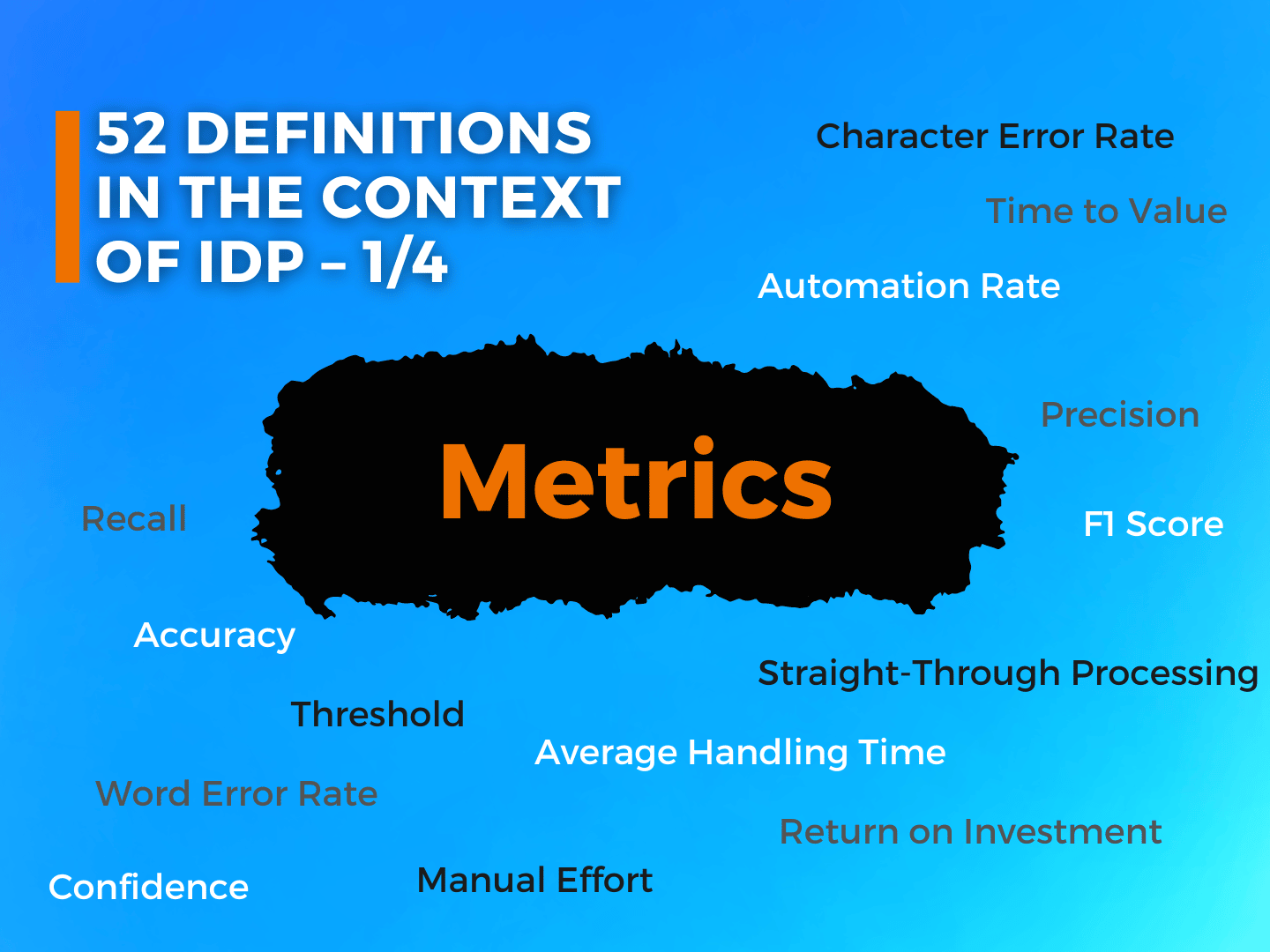Demystifying IDP: 52 Definitions in the Context of Intelligent Document Processing 1/4 – Metrics

Welcome to the 1st of our 4-part blog series on Intelligent Document Processing (IDP) definitions, where we will dive into fundamental keywords within the IDP context.
In Part 1, we will focus on metrics and explore their significance in understanding and measuring the performance of IDP solutions. Subsequent parts will cover other essential aspects such as the technology (2), deployment (3), and industries (4) associated with IDP. By clearly defining these terms, we aim to provide a comprehensive understanding of IDP and its components, enabling organizations to navigate the world of document automation with ease and clarity. So, let’s dive into the realm of IDP metrics and lay a solid foundation for our exploration of this transformative technology.
Accuracy
OCR Accuracy is defined as the process of comparing the output of OCR with the original version of the same (ground truth) text. The metrics used for measurement are Character Error Rate (CER) and Word Error Rate (WER). Other accuracy measurements can include the system’s accuracy (of all output) or accuracy of specific tasks (e.g., document classification, field extraction).
Automation Rate
In the context of IDP, Automation Rate refers to the percentage of documents or data records that can be successfully processed and handled automatically without the need for manual intervention. This metric indicates how well an IDP system can automatically process documents or data without human involvement. A higher automation rate signifies a greater level of efficiency and reduced dependency on manual labor for document processing tasks.
Average Handling Time (AHT)
AHT is an important metric when measuring the effectiveness of Digital Process Automation. It refers to the average amount of time a human takes to process one transaction or document.
Character Error Rate (CER)
CER is a metric used to assess the accuracy of text recognition systems, particularly in the context of Optical Character Recognition (OCR) or Intelligent Character Recognition (ICR). It measures the percentage of incorrectly recognized characters compared to the total number of characters in the reference (ground truth) text. A lower CER indicates higher accuracy in character recognition.
Confidence
Confidence can be defined as a “reliability score” for AI models and algorithms. A confidence score is a number between 0 and 1 that represents the likelihood that the output of a Machine Learning model is correct and will satisfy a user’s request.
F1 Score
The F1 Score is a Machine Learning metric between 0 and 1, defined as the harmonic mean of Precision and Recall. It provides a balanced assessment of the model’s ability to correctly identify relevant information while minimizing both false positives and false negatives. A higher F1 Score indicates a more accurate and reliable IDP system.
Manual Effort
Manual Effort refers to the exertion and tasks performed by individuals through manual processes, distinct from automation or automated processes.
Precision
Precision is an evaluation metric for AI models and is mainly used for information retrieval tasks. It describes the proportion of predictions that match the annotations in the test set. In simpler terms, Precision measures the accuracy of positive predictions and can be seen as a measure of quality.
Recall
Similar to Precision, Recall is an evaluation metric for AI models. It describes the proportion of annotations in the test set that are correctly predicted. In easier terms, Recall measures the completeness of positive predictions and can be seen as a measure of quantity.
Return on Investment (ROI)
ROI is a ratio between net income (over a period) and investment (costs resulting from an investment of some resources at a point in time). A high ROI means the investment’s gains compare favorably to its cost. As a performance measure, ROI is used to evaluate the efficiency of an investment or to compare the efficiencies of several different investments.
Straight-Through Processing (STP)
STP is a term used to denote the process in which a document is completely processed by an IDP solution without the need for human intervention or validation, thus passing “straight-through” the processing phase to the destination system without a validator in the loop.
Threshold
To turn individual confidence scores into actionable data, you need to apply a Threshold that determines, statistically, if data is probably correct or incorrect. A Threshold is a value between 0 and 1 and can be used, for example, as a filter parameter.
Time to Value (TTV)
TTV is similar to Return on Investment (ROI), but instead of realizing the financial success of an investment, it implies achieving the effectiveness of an investment. In the case of IDP, that is the time it takes to reach an optimal level of accuracy and precision when extracting data from documents – the longer the time, the lower the return on investment.
Word Error Rate (WER)
WER is a metric used to evaluate the accuracy of text recognition algorithms. It calculates the percentage of incorrectly recognized words compared to the total number of words in the reference text. Like Character Error Rate (CER), a lower WER indicates better performance and higher accuracy.
